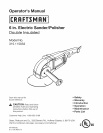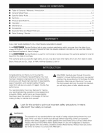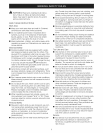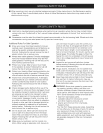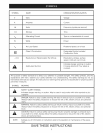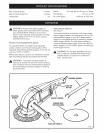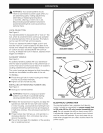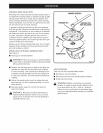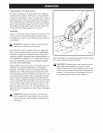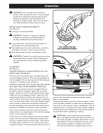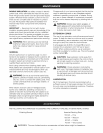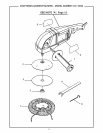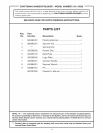
lilililililililihL
SANDING DISC SELECTION
Selecting the correct size grit and type sanding disc is
an extremely important step in achieving a high quality
sanded finish. Aluminum oxide, silicon carbide, and
other synthetic abrasives are best for power sanding.
Natural abrasives, such as flint and garnet are too soft
for economical use in power sanding.
In general, coarse grit will remove the most material
and finer grit will produce the best finish in all sanding
operations. The condition of the surface to be sanded
will determine which grit will do the job. If the surface
is rough, start with a coarse grit and sand until the
surface is uniform. Medium grit may then be used to
remove scratches left by the coarser grit and finer grit
used for finishing of the surface.
Always use the proper grit sanding disc, and not extra
pressure when sanding. Continue sanding with each
grit until surface is uniform.
INSTALLING OPTIONAL SANDING DISC
See Figure 4.
[] Unplug your sander/polisher.
_ WARNING: Failureto unplug your sander/polisher
could result in accidental starting causing possible
serious personal injury.
[] Position the tool as shown in figure 4 and align the
spindle lock hole with the two half-circle notches
in motor housing. Lock spindle by inserting the pin
provided through spindle lock hole and trapping it
in half circle notches. This will prevent spindle from
rotating.
[] Center the sanding disc over the rubber disc and
start spanner nut onto threaded spindle in a clock-
wise direction.
[]
Securely tighten spanner nut with the spanner
wrench provided.
_ ARNING: Remove pin before attempting to
operate sander/polisher. Failure to do so could
cause pin to be thrown from the tool resulting in
possible serious injury.
SPANNERWRENCH
SPANNER NUT
SANDINGDiSC
(NOT INCLUDED)
PiN
RUBBER DiSC
Fig. 4,
APPLICATIONS
(Use only for the purposes listed below)
[] Sanding on wood surfaces.
[] Removing rust from and sanding steel surfaces.
[] Polishing and buffing.
A
WARNING: Before connecting your sander/
polisher to power supply source, always check
to be sure switch is not in "lock-on" position.
Failure to do so could result in accidental start-
ing of your sander/polisher resulting in possible
serious injury.



